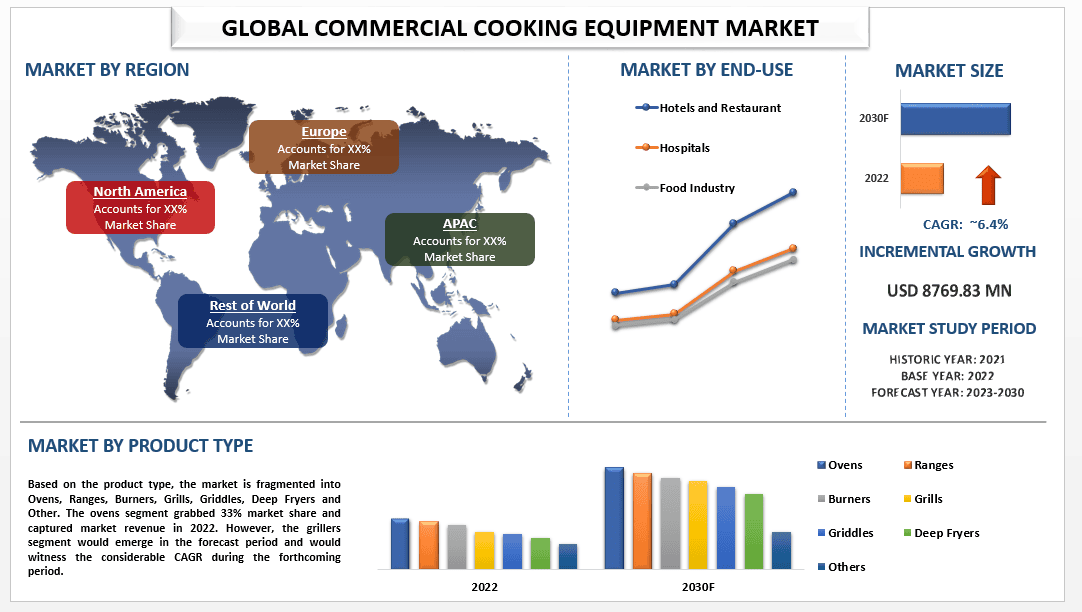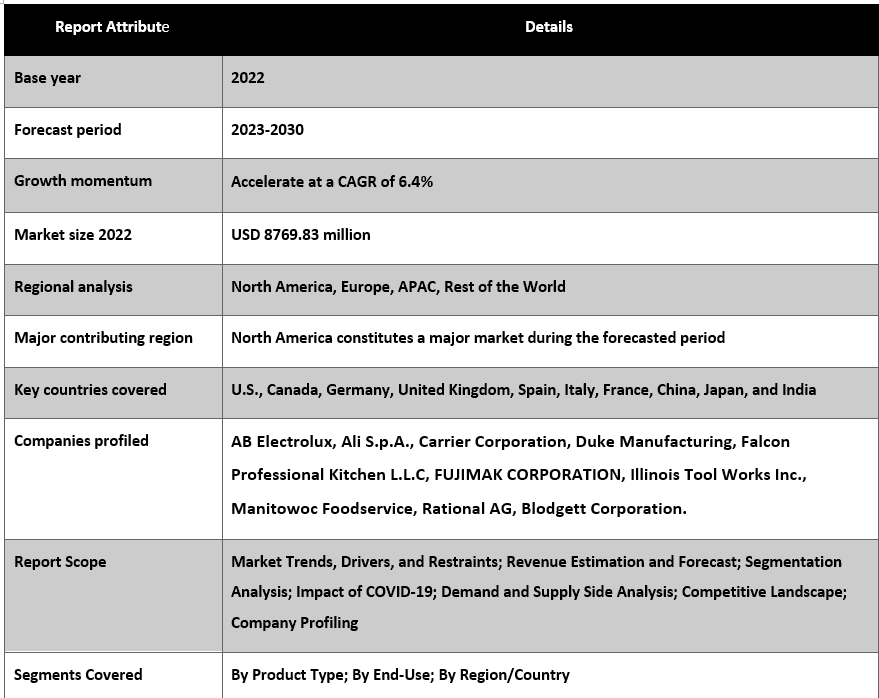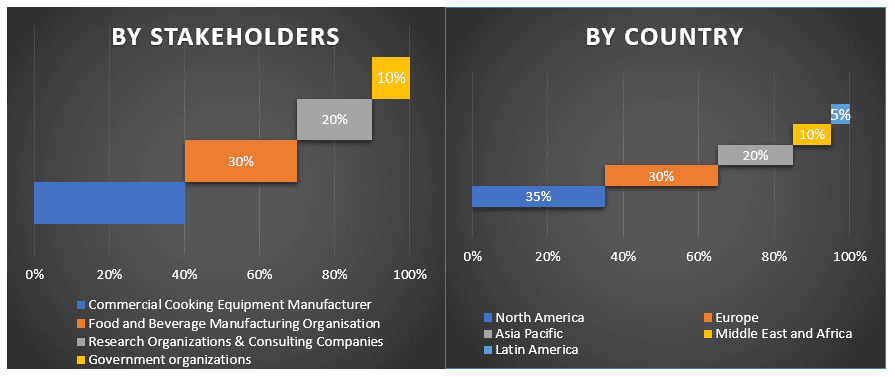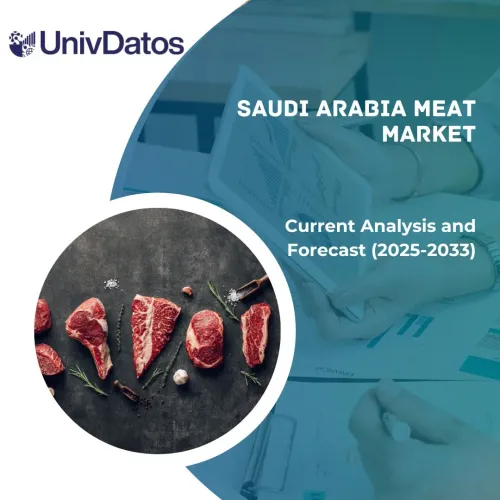- Home
- About Us
- Industry
- Services
- Reading
- Contact Us
Commercial Cooking Equipment Market: Current Analysis and Forecast (2023-2030)
Emphasis on Product Type (Ovens, Ranges, Burners, Grills, Griddles, Deep Fryers, Others); End-Use Type (Hotels and Restaurant, Hospitals, and Food Industry); Region/Country

Global Commercial Cooking Equipment Market was valued at US$ 8769.83 million in 2022 and is anticipated to reach US$ 14.6 Billion by 2030 displaying an elevated CAGR of 6.4% over the forecast period (2023-2030).
The increased per capita spending of consumers on food worldwide has inclined them towards fast, convenient, and healthy modes of cooking which require less cleaning time. For instance, in 2021, Japan has the highest per capita spending on food which is USD 4417.5 per person followed by Australia, Canada, and France with per-person spending of USD 3,003.6, USD 2986.9, and USD 2983.4, respectively. This has been an increasing need for cooking equipment at restaurants, cafes, and hotels, as well as for residential use. Hence, boosting the commercial cooking equipment market.
Also, Processed foods occupy a significant share of many diets around the globe as these are widely available, cheap, and intensively marketed. The demand for commercial cooking equipment is rising dramatically across the globe owing to the growing consumption of processed food in many high-income countries leading to the increase in sales of processed and packaged food. For instance, the sales of packaged food across the globe were nearly USD 2,339.7 million in 2020 and was gradually increased to USD 2578.9 million in 2021 and USD 2,644.1 million in 2021. Furthermore, advancement in technologies used in the manufacturing of food and beverages to maintain and prolong the shelf life of products to enhance the quality of the food is also propelling market growth.
AB Electrolux, Ali S.p.A., Carrier Corporation, Duke Manufacturing, Falcon Professional Kitchen L.L.C, FUJIMAK CORPORATION, Illinois Tool Works Inc., Manitowoc Foodservice, Rational AG, The Middleby Corporation, etc, are some of the prominent players operating in the Commercial Cooking Equipment market. Several M&As along with partnerships have been undertaken by these players to facilitate customers with hi-tech and innovative products.
Insights Presented in the Report
“Amongst Product Type, Oven segment holds the major share”
Based on the product type, the market is fragmented into Ovens, Ranges, Burners, Grills, Griddles, Deep Fryers and others. The ovens segment grabbed 33% market share 2022. Ovens are highly versatile appliances, capable of cooking a wide range of foods, including baking, roasting, broiling, and more. This versatility makes them a popular choice among consumers, as they can be used for various cooking purposes. Ovens provide convenience to users by offering features like programmable timers, pre-set cooking functions, and self-cleaning options. These features make cooking with ovens easier and less time-consuming, which appeals to busy individuals or those who prefer effortless cooking. However, the grillers segment would emerge in the forecast period and would witness a considerable higher CAGR during the forthcoming period.
Commercial Cooking Equipment Market Report Coverage

“North America represents one of the largest markets of Commercial Cooking Equipment market”
North America constitutes a major market for the Commercial Cooking Equipment Market industry and generated revenue in 2022. North America has a robust and diverse foodservice industry comprising restaurants, cafes, hotels, catering businesses, and other establishments. This industry serves a large population base, including locals and tourists, leading to high demand for commercial cooking equipment. The hospitality sector in North America is experiencing steady growth, fueled by an increase in tourism and business travel. As a result, hotels, resorts, and other accommodation providers require commercial cooking equipment to cater to their guests’ dining needs.
Reasons to buy this report:
- The study includes market sizing and forecasting analysis validated by authenticated key industry experts
- The report presents a quick review of overall industry performance at one glance
- The report covers an in-depth analysis of prominent industry peers with a primary focus on key business financials, product portfolio, expansion strategies, and recent developments
- Detailed examination of drivers, restraints, key trends, and opportunities prevailing in the industry
- The study comprehensively covers the market across different segments
- Deep dive regional level analysis of the industry
Customization Options:
The Commercial Cooking Equipment Market can further be customized as per the requirement or any other market segment. Besides this, UMI understands that you may have your own business needs, hence feel free to connect with us to get a report that completely suits your requirements.
Table of Content
Research Methodology for the Global Commercial Cooking Equipment Market Analysis (2023-2030)
Analyzing the historical market, estimation of the current market, and forecasting the future market of the Commercial Cooking Equipment Market were the three major steps undertaken to create and analyze the demand for Commercial Cooking Equipment across major regions. Exhaustive secondary research was conducted to collect the historical market numbers and estimate the current market size. Secondly, to validate these insights, numerous findings and assumptions were taken into consideration. Moreover, exhaustive primary interviews were also conducted, with industry experts across the value chain of the Commercial Cooking Equipment market. Post assumption and validation of market numbers through primary interviews, we employed a top-down/ bottom-up approach to forecast the complete market size. Thereafter, market breakdown and data triangulation methods were adopted to estimate and analyze the market size of segments and sub-segments the industry pertains to. Detailed methodology is explained below:
Analysis of Historical Market Size
Step 1: In-Depth Study of Secondary Sources:
Detailed secondary study was conducted to obtain the historical market size of the Commercial Cooking Equipment through company internal sources such as annual reports & financial statements, performance presentations, press releases, etc., and external sources including journals, news & articles, government publications, competitor publications, sector reports, third-party database, and other credible publications.
Step 2: Market Segmentation:
After obtaining the historical market size of the Commercial Cooking Equipment market, we conducted a detailed secondary analysis to gather historical market insights and share for Product types, end-use for major regions. Major segments included in the report are product type and End-Use. Further region and country-level analyses were conducted to evaluate the overall adoption of Commercial Cooking Equipment across the globe.
Step 3: Factor Analysis:
After acquiring the historical market size of different segments and sub-segments, we conducted a detailed factor analysis to estimate the current market size of Commercial Cooking Equipment. Further, we conducted factor analysis using dependent and independent variables such as the Rising number of International Tourists Across Countries, Blooming Hospitality Sector, and Introduction of Smart Cooking Equipment, etc., A thorough analysis was conducted for demand and supply-side scenarios considering top partnerships, merger and acquisition, business expansion, and product launches in the Commercial Cooking Equipment industry across the globe.
Current Market Size Estimate & Forecast
Current Market Sizing: Based on actionable insights from the above 3 steps, we arrived at the current market size, key players in the Commercial Cooking Equipment market, and market shares of the segments. All the required percentage shares split, and market breakdowns were determined using the above-mentioned secondary approach and were verified through primary interviews.
Estimation & Forecasting: For market estimation and forecast, weightage was assigned to different factors including drivers & trends, restraints, and opportunities available for the stakeholders. After analyzing these factors, relevant forecasting techniques i.e. bottom-up/top-down approach was applied to arrive at the market forecast about 2027 for different segments and subsegments across the major markets globally. The research methodology adopted to estimate the market size encompasses:
- The industry’s market size, in terms of value (US$) and the adoption rate of Commercial Cooking Equipment across the major markets domestically
- All percentage shares, splits, and breakdowns of market segments and sub-segments
- Key players in the Commercial Cooking Equipment market in terms of services offered. Also, the growth strategies adopted by these players to compete in the fast-growing market
Market Size and Share Validation
Primary Research: In-depth interviews were conducted with the Key Opinion Leaders (KOLs) including Top Level Executives (CXO/VPs, Sales Head, Marketing Head, Operational Head, and Regional Head, Country Head, etc.) across major regions. Primary research findings were then summarized, and statistical analysis was performed to prove the stated hypothesis. Inputs from primary research were consolidated with secondary findings, hence turning information into actionable insights.
Split of Primary Participants in Different Regions

Market Engineering
Data triangulation technique was employed to complete the overall market estimation and to arrive at precise statistical numbers of each segment and sub-segment of the Commercial Cooking Equipment market. Data was split into several segments & sub-segments post studying various parameters and trends in the areas of Product Type and End-Use of the Commercial Cooking Equipment market.
Main Objective of the Commercial Cooking Equipment Market Study
The current & future market trends of Commercial Cooking Equipment were pinpointed in the study. Investors can gain strategic insights to base their discretion for investments from the qualitative and quantitative analysis performed in the study. Current and future market trends were determined the overall attractiveness of the market at a regional level, providing a platform for the industrial participant to exploit the untapped market to benefit as a first-mover advantage. Other quantitative goals of the studies include:
- Analyze the current and forecast market size of Commercial Cooking Equipment in terms of value (US$). Also, analyze the current and forecast market size of different segments and sub-segments
- Segments in the study include areas of product type and end-use
- Define and analysis of the regulatory framework for the Commercial Cooking Equipment industry
- Analyze the value chain involved with the presence of various intermediaries, along with analyzing customer and competitor behaviors of the industry
- Analyze the current and forecast market size of the Commercial Cooking Equipment market for the major countries
- The major region studied in the report includes North America, Europe, Asia- Pacific and Rest of the World.
- Company profiles of the Commercial Cooking Equipment market and the growth strategies adopted by the market players to sustain in the fast-growing market
Deep dive regional level analysis of the industry
Related Reports
Customers who bought this item also bought










